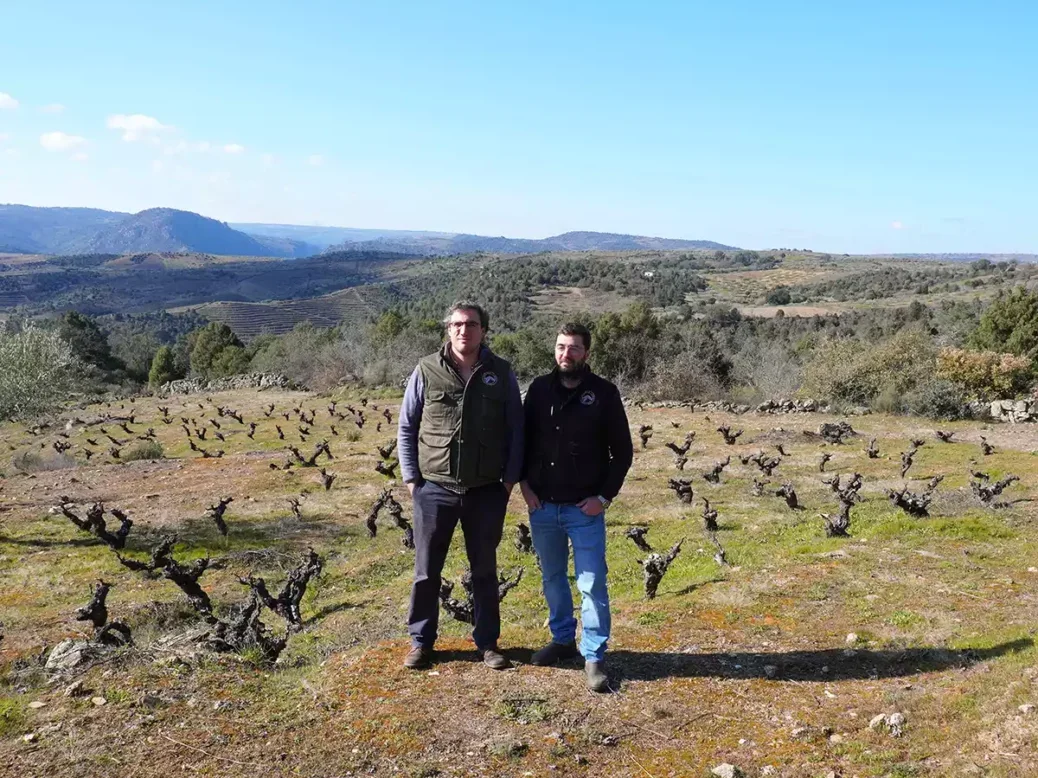
Simon J Woolf visits the adventurous producers of Trás-os-Montes.
People here don’t want to sell their vineyards,” explains Frederico Machado. “They believe that their children will one day return home and want to work on the land.” As we drive through the barren highlands of the Planalto Mirandês, he smiles wryly. “It will never happen.”
Machado is one half of Arribas Wine Company, a boutique winemaking project founded in Trás-os-Montes ( “behind the mountains”) with his friend Ricardo Alves in 2017. The two met while they were studying winemaking in Vila Real. They make an interesting double act. Sporting John Lennon-style round glasses when I met him, Fred channels an almost Liverpudlian quick and sardonic wit. Ricardo is the straight man, often seemingly withdrawn and taciturn, but given to suddenly coming alive when the topic of conversation suits him.
Ricardo is originally a local, whereas Fred grew up farther west in Braga, part of the Minho, better known as Vinho Verde. Despite these differences, the pair share a passion and deep belief in the potential of Trás-os-Montes. If that sounds trite, it is anything but. Few of their colleagues in the Portuguese wine industry would have credited this massive, northeasterly backwater with much potential.
It’s a tricky region to understand geographically, partly because the administrative, cultural, and wine-denominated areas are all significantly different—in some cases, overlapping with parts of the Douro. The Douro River itself continues into southeastern Trás-os-Montes and onward into Spain. The administrative region Trás-os-Montes is vast, occupying an area more than twice the size of the demarcated Douro region. It is bordered by Vinho Verde to the west, Spain to the north and east, and the Douro to the south. The easterly area around Miranda do Douro, Mogadouro, and Vimioso is perhaps the most culturally distinct because it has its own language—Mirandese—which, since 1998, has had official recognition by the Portuguese government. In terms of wine, only three relatively small “islands” within the region qualify for DOC status. These are clustered around Chaves, Valpaços, and the Planalto Mirandês, which traverses the easterly border with Spain. The rest of Trás-os-Montes is denominated by the overarching IGP (Vinho Regional) Transmontano.
Trás-os-Montes has always had a reputation for being poor and underdeveloped, even compared to the most rural backwaters of the Douro Superior or the simple farming communities in the Minho. It’s geographically cut off from just about everywhere, with historically bad road links to the westerly coastline and an impressive range of mountains separating it from easterly Spain. Ever more sparsely populated, and with little industry apart from farming, this is not a place where opportunity knocks very often. Fred, who lives in the village of Bemposta, where the duo also have their cellars, mentions that even the nearest ATM is a 12-mile (20km) round trip away.
The region’s reputation in wine terms is as a bulk-wine producer, with a mediocre sprinkling of cooperative cellars and a few large operations specializing in sparkling wine or rosé. Trás-os-Montes also claims to be the source of most of the grapes for Sogrape’s Mateus Rosé, still one of Portugal’s biggest wine exports. According to the Comissão Vitivinícola Regional de Trás-os-Montes, there are only 85 registered producers in the region, and 11,010ha (27,200 acres) of vines. Unlike all of Portugal’s other wine regions, Trás-os-Montes doesn’t have its own tasting panel to approve the wines, which are instead sent to the Douro’s IVDP. “Every Trás-os-Montes DOC wine effectively becomes a second-division Douro wine,” says Fred.
Not just hot
I didn’t realize back in 2019, when I first visited, but Trás-os-Montes’s second-division consignment had exerted its influence on me. I regarded it as a continuation of the Douro Superior, assuming it had a similarly hot and dry climate. Visiting Quinta de Arcossó near the town of Chaves confirmed my assumption. I tasted ripe, concentrated wines, high in alcohol and big on oak influence. Owner-winemaker Amilcar Salgado showed us some extraordinary old vineyard plots, with bush vines scattered among what looked for all the world like a wild desert garden. His commitment to working these treasures was admirable, but the wines did nothing to help me understand the region.
I could hardly have been more wrong about the climate. Trás-os-Montes has the coldest winters anywhere in Portugal, and it also divides into two distinct zones—the so-called terra fria (cold land) to the northwest, and terra quente (hot land) to the southeast. But even the warmer areas typically experience more evenly distributed rainfall and cooler winter temperatures than the Douro—a dry and fiery furnace by comparison.
Fred and Ricardo knew that the granite hinterlands around the Planalto Mirandês had a different story to tell, beyond being an also-ran to the Douro. Bemposta is just a few miles away from the Spanish region of Arribes, and the pair decided to name their project for its Portuguese translation, Arribas. There is no such denomination in Trás-os-Montes, but as Fred explains, the existing DOC feels so meaningless to them that the idea of Arribas held far more significance. Their concept also encompasses the idea of a cross-border growers’ association, and they are working actively with a small number of growers in Spain to create this partnership.
The pair had to circumvent considerable challenges to secure their first vineyards, because the locals initially regarded them not just with suspicion but also incredulity: Why would anyone want to work old vineyards that produce almost nothing? They currently rent around 30 different parcels scattered across six different villages. “Now people come to us,” says Fred. The plots are generally rented with long-term contracts, and in most cases Fred and Ricardo do the vineyard work themselves. Many of the parcels are very old, with bush-trained, 80- to 100-year-old plants the norm.
With so much of Trás-os-Montes’s existence hanging on the coattails of the Douro, it would be reasonable to assume that a similar range of grape varieties is typical here. But that also turns out not to be the case. Touriga Nacional, the poster-boy red of the Douro, was never historically planted in Trás-os-Montes. Tinta Roriz, aka Tempranillo, similarly has no place here. But that hasn’t stopped many old plots being grubbed up and replaced with these modern superstars. As in so many parts of northern Portugal, field blends have also been dominant, but the varieties you’d typically find would be Tinta Gorda (better known as Juan García in Spain), Tinta Serrana, Bastardo, or Verdelho Vermelho (red Verdelho). Most old vineyards have a substantial proportion of white grape varieties mixed in with everything else, with the likes of Malvasia Fina or Gouveio (here known as Verdelho), Bastardo Branco, and Porto Branco common. With a host of international grape varieties allowed in the Vinho Regional classification, it can be difficult to get any perspective on what was once typical in the region. Most sources of information merely trot out an Identikit list of Douro varieties, plus Cabernet, Sauvignon, Gewürztraminer, and so forth.
Most of the vineyards worked by Fred and Ricardo are a mix of red and white grape varieties, as is reflected in their vinifications and bottlings. It’s a fair assumption that anything labeled tinto is going to contain at least a small proportion of white grapes. Cellar practice is low on intervention, with the aim of prioritizing freshness and vineyard expression. Maceration times for both reds and whites are kept very short, and most wines age for a year or more in used/neutral oak vessels (various formats) before bottling. Sulfur dioxide is the only additive. When I first tasted the Arribas wines, in 2021, I wasn’t sure what to make of them. The Saroto red and white blends felt feather-light and a mite simplistic given the backstory. Even the higher-level vineyard selections, such as Quilómetro, seemed somewhat insubstantial.
Two issues were at play here. The first was my misconception about Trás-os-Montes’s climate and terroir—I was expecting big, heavy wines. The second was something that Ricardo admitted to me in 2022: They had started out bottling and releasing their wines much too early. The output from these low-yielding old vines speaks of the region. The wines often have a lean, gnarly side that needs a year or two of barrel aging before it softens and integrates. Tinta Gorda, in particular, needs careful handling, since it can be a brutally tannic creature. With patience, the reds show bright redcurrant or cranberry fruit, often with velvety texture. A Saroto Branco 2018, with just 10.5% alcohol, has really hit its stride now, with delicate tarragon and lime scents and a Riesling-like hint of petrol.
Fred and Ricardo work out of two rather cramped cellars in Bemposta, but in 2023 acquired the use of a more spacious winery in the village of Vila Chã de Braciosa. Biliplana was an abortive project from a pharmacy owner who moved to the Douro in 2014. They’ve taken the opportunity to work with additional growers, and thus there are now separate bottlings of wines under a new Biliplana brand. The Bilaplana 2022 Tinto (actually a 60/40 blend with white grapes), tasted February 2024, shows gorgeous berry fruit, a nicely rounded, chalky texture and attractive herbal notes on the finish. It was produced from a vineyard where Bastardo dominates but has remained light and restrained; Bastardo in the Douro is renowned for its ability to give high sugar and alcohol.
The Biliplana cellar is also being used as an overflow by a colleague whom Fred and Ricardo have mentored. António Picotês comes from a family based in nearby Sendim that made continuously for generations. He had embarked on a career as a civil engineer, working in Porto, when his dad died unexpectedly from a brain tumor in 2018. “That was the only year that no wine has been made in this cellar,” he says poignantly, as we taste from the tanks and barrels in the high-beamed family winery. António decided he had to take up the challenge and now makes wine in his spare time. It’s a noble pursuit, since the family owns some wonderful old-vine parcels, one of which is situated right outside their living room. António’s first commercial releases were from the 2021 vintage. His wines typically show a little more ripeness than those of Arribas Wine Company, albeit with the same brightness and freshness. A 2022 Palhete (a traditional style with roughly 80% red and 20% white grapes) impressed me with its soft, raspberry kiss. Piçarrão is his top selection, unusually made from 100% red grapes. The just-released 2022 expresses wonderfully spicy berry fruit and has what Michael Broadbent MW might have termed perfect weight. It’s ripe but not in any way overbearing. It was aged in barriques, and the oak has integrated well. I was particularly taken with António’s Branco 2021, a blend of mostly Malvasia Fina and Verdelho (aka Gouveio). Clocking in at just under 13% ABV, it has a silken and inviting texture, with a sensation of ripeness and richness.
The village of “Grape”
The vineyards near Bemposta can seem quite otherworldly, hidden far away from main roads and often accessed only by treacherously rocky tracks. Their elderly denizens seem to have achieved a kind of Zen state. They’ve endured for a century, sometimes more. Fred takes me to a stunning site he calls Horatio, for the similarly aging owner. It sits on a high plateau that then drops, canyon-like, down to the steep cliffs of the Douro River. Boulders and isolated cherry trees litter the landscape. A little farther north, in the village of Uva, the terrain feels yet more barren. Here at 1,800ft (550m), Trás-os-Montes is at its bleakest and most arid. The village itself has a mere 15 permanent residents, though there must be more than 100 houses, in various states of disrepair. Far outnumbering the residents—and probably the houses, too—are the pombais: whitewashed, squat, stone towers that provide a haven for pigeons, allowing the villagers to collect their excrement for use as fertilizer and (historically) the birds themselves for food.
Since 2017, the village has had two more inhabitants. Aline Domingues was brought up in France, but Uva is her father’s ancestral village, and it’s here that she decided to make her home and her wine. Her brand, Menina d’Uva—translating literally as “Girl of the Grape”—couldn’t be any more apt. Her Italian partner Emmanuele came to the region from his native Marche, originally as a volunteer at the local donkey sanctuary. He has now become an integral part of the winery project. Aline’s uncle and grandfather both own vineyards around the village, and she rents these and a number of other parcels. She also planted 2.5ha (6 acres) between 2020 and 2021. Working out of a minute stone cellar in the village, Aline’s total production is around 10,000 bottles—at least until those new vines come of age. She’s now also building a new dedicated cellar.
Her background is microbiology, with a master’s in the fermentation of cheese, beer, and wine, but Aline’s approach to winemaking is not in any way dogmatic or driven by science. She makes wine in pretty much the same way her grandfather might have done, without any additives, including sulfur. Her wines beautifully express the wild, barren nature of the land. There is a feeling of heat, but it’s nicely reined in by smart harvest-date decisions. The wines don’t lack ripeness, but they feel lithe and digestible. For anyone who wants to understand the character of Tinta Gorda, try her Palomba (“Pigeon”) 2021, made from vineyards in Uva, where this variety dominates. The wine suggests wild forest fruits infused with fresh Mediterranean herbs. It’s structured, with quite spiky tannins. Empusa is labeled as a rosé but is actually a blend of red and white, both directly pressed. Her Palhete Ciste 2021 reverses the normal proportions for this style and is 60% white and 40% red; it’s perhaps the most angular of her wines, with relatively lean, red berry fruit, a spicy, menthol hint, and grippy tannins. Lichien Branco 2021 blends mostly Malvasia and Bastardo Branco (like all of her wines, it’s a field blend) and shows plentiful ripe melon and fresh herbs.
Aline, Fred, Ricardo, and António form a slightly renegade bunch in Trás-os-Montes. All situated around the Planalto Mirandês, they radiate with collegiate spirit and are frequently to be found in each other’s cellars. They’re not the only artisan winemakers in the region, though. The aforementioned Amilcar Salgato continues his valuable work with old vineyards in and around Chaves, even if his more classic winemaking style doesn’t personally resonate with me. A little farther northeast, close to the town of Bragança, an IT consultant working for PricewaterhouseCoopers also joined this elite group.
In love with old vines
Jorge Ortega Afonso is the man behind Casa do Joa, a boutique winery created in the village of Parada. He was inspired to create the project in 2009, after spending years watching old vines being ripped out or vineyard land sold off. “Why didn’t anyone create a brand to market these wines?” was the question he asked himself, explaining, “I tried to understand if it’s just not a good wine or not a good region.” He came to the conclusion that “people here don’t have the spirit of entrepreneurship. They just make wine for themselves to drink.”
He now has 8ha (20 acres) of vineyard, some rented but some that he purchased outright. His oldest plot has vines of up to 150 years old. He planted new vines between 2016 and 2017 but was forbidden to use the traditional gobelet or bush-training method. Regulations enforced by the local commisão forced him to use guyot training, something that has no history in the region and little proven suitability for the varieties or the climate.
Entrepreneurship is certainly not something that Afonso lacks. Not only has he created slick branding for his winery and labels, he has also branched out into the business of dried-chestnut flower extract. Inspired by Fernando Paiva (Quinta da Palmarinha), a biodynamic grower in the Minho, he started experimenting with dried chestnut flowers as a replacement for adding sulfur. The extract has some effectiveness in terms of preventing oxidation. At least for this writer’s palate, however, it does not offer any protection against mousiness. Where Paiva initially worked with whole chestnut flowers that he crumbled in a powder himself, Afonso has taken a more business-minded approach to make an extract that can be mass-produced and sold.
Although I am still to be convinced about the effectiveness or common sense of replacing one additive in wine with another, Afonsa has made some very convincing wines so far. He prefers a little more ripeness and body in his wines than his colleagues around the Planalto. Afonso’s vineyards are rich in Bastardo, Mourisco, Alvarhão, Jaen, and Cornifesto. His 2018 Alto do Joa Tinto, still in barrel when I visited in 2023, is particularly impressive, with great fruit purity and freshness. The 2019 (also currently in barrel) is from a much riper vintage but with the same fruit focus and well-judged use of oak. Alto do Joa Branco is a skin-fermented, or curtimenta, style. The 2019 is currently available and has wonderful lift and structure. The 2021, tasted from barrel, promises something similar—if anything, with even riper fruit. It is likely to be bottled just with chestnut-flower extract in place of any added sulfites.
“Maybe people forgot that we have a diamond here,” Afonso told me, adding a beautiful soliloquy to the old vines of Trás-os-Montes: “If the vines could speak, they could say they saw the First World War, the Wall Street Crash, the Second World War, and so on.” He added somewhat philosophically, “I will die—and they’ll still be here.” Frederico Machado’s dire warnings that no one will return to Trás-os-Montes to tend these vines in the future still echoed in my ear. But at least for the next few decades, there is a passionate clutch of individuals doing their very best to put the heritage from behind the mountains in a bottle.






